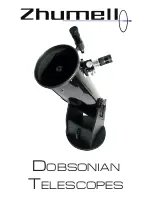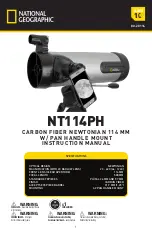
Cone error adjustment is most often used when the telescope is attached to a German equatorial mount, so that the polar axis of
the mount and the center of the telescope’s optical axis are aiming at the same point in the sky. Adjustment is done by trial and
error. Typically on an alt-azimuth mount, no such adjustments are necessary.
Note that when the final adjustments are made to the screws, that the center screw (
1, Fig. 15
) must have enough purchase into
the threads of the cradle ring so that it does not lose contact, and the two outer screws must be tightened snug enough to eliminate
any looseness of the dovetail saddle plate to the cradle rings.
Cleaning and Taking Care of the Comet Hunter
All telescope optics are subjected to some dust and dirt as they are intended to be used outdoors. Indeed even if the optics are
pristine from particles that you could see with the naked eye, it will be quite impossible to keep any telescope optics free from dust
as you use it. Experience will show you that a few particles on any optical surface (inside or out), as they will not affect visual or
photographic performance. But there is a point when optics can become uniformly dirty and it will affect image contrast.
As with any fine piece of optical equipment, do your best to prevent exposure to dust and moisture. This will reduce how often you
will be required to clean the optics. This advice is not only for when the telescope is being used in the field, but when the telescope
is stored in its case.
Use the supplied dew shield as often as possible, as it will help to protect the Maksutov corrector plate from the elements. The dew
shield not only prevents dew from forming, and dust from settling on the corrector plate lens, it prevents stray light from reducing
image contrast. Although the dew shield will greatly aid in moisture buildup, it can still occur during nights when dew conditions
become severe. Wet optics are not harmful to the telescope, but the instrument should not be packed away in its case until the
moisture has completely evaporated. You can accelerate evaporation with a hair dryer or just by setting up the telescope in a dry
environment with the dust covers removed. Packing the telescope away in its case when it is wet will result in a steam bath
environment, which can allow mold and fungus to grow on the optics.
Never attempt to wipe down optics that are covered with dew with a dry cloth, tissue, or cotton ball, as dust and dirt may be trapped
in the moisture, which will scratch the optics when you attempt to wipe it clean. Dry the optics first and then follow the cleaning
procedure if necessary. Often you will find the optics still in fine condition after the dew has evaporated and will not require
cleaning.
If you live in a very moist climate, you may find it necessary to
use silica desiccant stored in the telescope’s case to ward off
moisture and the possibility of fungus or mold growing on and within the coatings of the optics. Replace the desiccant as often as
necessary. Those living in coastal areas or tropic zones should consider applying a water displacement solution on the metal
surfaces of the telescope (being careful not to apply it to the optics).
A thick layer of dust will attract and absorb moisture on all exposed surfaces. Left unattended, it can cause damaging corrosion. To
keep dust at bay when observing outdoors, the telescope can be set up on a small section of indoor/outdoor carpet. If you are
observing for more than one night in a row, the telescope can be left set up but covered with a large plastic bag. Eyepieces and
other accessories are best kept in plastic bags with silica desiccant and stored in cases.
All of the non optical surfaces of the Comet Hunter should be cleaned occasionally with a soft rag to prevent corrosion. The cast
metal surfaces and the individual exposed screws can also be kept looking new and corrosion free by wiping them down with a
water displacement solution (such as WD-40). Take care not to smear the solution onto the optical surfaces, and to wipe up any
excess solution with a clean, dry, soft cloth. The carbon fiber tube can be polished with a liquid car polish and a soft polishing cloth.
Regular Optical Cleaning:
It never hurts to use filtered, compressed air on your optics, or to use a photographic-grade camel hair brush. Indeed you will find
that most professional photographers will double check the optical surfaces and give them a quick dusting before using their
cameras, you can do the same when you use your telescope.
You can use canned, compressed air as found in camera stores. Be careful not to tip the can, because frozen propellant will come
out and leave a layer on your optics that will then require cleaning with fluid and tissues or cotton balls. Start by giving a few quick
bursts on your hand to make sure that only air is coming out, then with the can held vertical give a few quick bursts of air to remove
dust. If you have an air compressor, use two in-line filters to prevent spraying oil on your optics. Another alternative is to use an ear
syringe (available from a local pharmacy) to blow off dust.
The ear syringe does not have the force of compressed air, but it doesn’t
have the problems of compressed air, and it never requires to be refilled.
Stubborn dust particles can be removed with a photographic-grade camel hair brush. They come in different sizes, depending on
the size of the optics that you will want to clean. Only use very gentle brush strokes on the optics and follow up by blowing off the
dust with compressed air or the ear syringe.
If brushing and blowing off the dust on your optics does not clean them, then it is time to use cleaning fluids. You will know that the
optics will require further cleaning, if they appear to be hazy, have fingerprints, or other buildup of pollens, tree resins, grease, etc.



























